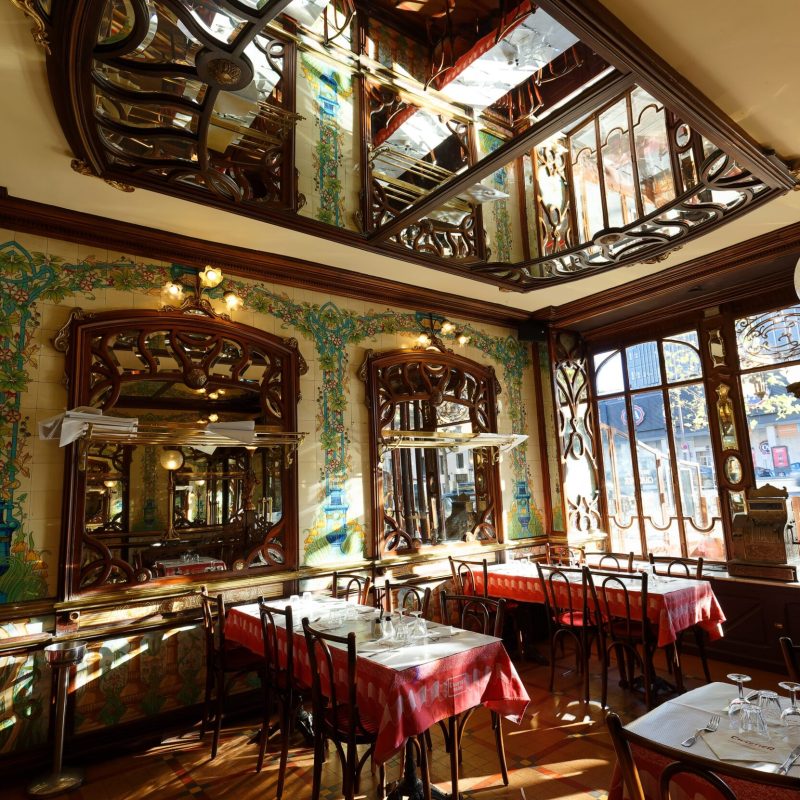
Navigating the different types of eating establishments in Paris can be a pleasant challenge to undertake when visiting. Brasseries, bistros, cafes, and salons de thes are among the standard establishments, but there’s one more to add to the list: bouillons.
Videos by TravelAwaits
The story goes back to 1855, when a Parisian butcher, Pierre Louis Duval, served a basic dish of bouillon, or broth with a hunk of meat in it, to local workers at the market as an inexpensive but hearty meal. The idea gave way to a new category of restaurants called bouillons, which served familiar French dishes such as leeks vinaigrette, beef bourguignon, escargot, pot a feu, and creme caramel at affordable prices.
Bouillons became a familiar sight in almost every area of Paris, and by the end of the 1800s, there were over 250 of them serving the masses. The interiors were massive, open dining rooms serving hundreds of diners at a time with a fast turnover, similar to cafeterias in the U.S. during the same time period. But by the 1980s, bouillons were almost extinct, with many of them closing due to new French dining trends, especially nouvelle cuisines, where supposedly less food was more.
In fashion as well as in food, what’s new is old, and what’s old is new; bouillons have made a strong comeback in the past three years, and the newly opened ones still provide good food at modest prices, where a three-course meal can cost as little as 18 euros or $20 USD per person, not including wine, which is typically four to six euros per glass.
Here’s a list of the best bouillons in Paris at the moment.
Bouillon Julien
Originally opened in 1906, Bouillon Julien, has been through various changes in ownership and menus, but the constant has been the exquisite decor of the restaurant. No expense was spared during the extravagant art nouveau design period in the early 1900s, and French artist Louis Edouard Fournier, a painter and illustrator, was commissioned to design the interior of the restaurant. Fournier brought in the top artisans of the period to create stunning architectural details; Louis Majorelle designed the mahogany bar, Armand Segaud created the peacock panels, and Charles Buffet, father of painter Bernard Buffet, designed the stained glass ceiling.
In its heyday, singer Edith Piaf was frequently spotted at Bouillon Julien, dining with her lover, Marcel Cerdan, the champion boxer, who later tragically died in an airplane crash.
In 1938, it was under new ownership and became just Julien, and in 1975 it was taken over by a large restaurant conglomerate. By the new millennium, Julien had seen better days and seemed out of place on a street filled with thrifty Turkish restaurants and casual cafes.
Julien was bought by a new owner in 2018 and the name Bouillon Julien was restored. British designer John Whelan faithfully restored Bouillon Julien, as much as possible, to its original, glorious design. Whelan did some research and found out that the walls were first painted a sea green color, and the dingy, tobacco color that was present was from the decades of cigarette smoke. Returning the walls to sea green, the gorgeous architectural details now look fresh and new.
The first course choices on the menu are so tempting, you can order two and not break the bank, although you may exceed your ideal calorie count. Selections include leek salad with hazelnuts, hard boiled eggs with mayonnaise, Burgundy snails with garlic, parsley, potato, and leek soup, and duck liver pate with toast points.
For the main course, Bouillon Julien, made with beef broth and braised beef, harkens back to the origins of the bouillon but is infused with fregola pasta, ginger, and lemongrass. Other traditional French dishes are revived, including steak frites, tete de veau, duck confit with French fries, and blanquette de veau.
Chocolate mousse, rice pudding with salted butter, caramel sauce, and lemon meringue tart are just a few of the desserts offered.
Bouillon Julien is open seven days a week for lunch and dinner. Reservations are recommended.

Bouillon Pigalle
Bouillon Pigalle, launched in 2018, almost single-handedly started the revival of the bouillon. Spanning two floors, with two dining rooms and an outdoor terrace, there’s seating for over 300 people. Bouillon Pigalle was an instant hit, and now patient Parisians and tourists stand in line during lunch and dinnertime for a much-coveted table (Bouillon Pigalle does not take reservations).
The decor of the dining room takes its cue from past bouillons, with long, communal tables with white tablecloths, red leather banquettes, bentwood chairs, and wood floors. Flowering plants are placed on wood, slatted shelves to give some softness, and uniform, floor-to-ceiling columns display vintage posters.
The location of Bouillon Pigalle, in the heart of Pigalle, is a big draw, as the neighborhood is known for its lively nightlife scene of clubs and bars and its close proximity to the Moulin Rouge and Montmartre.
Bouillon Pigalle prides itself in sourcing most of its ingredients either locally or from somewhere in France. They shop daily at the largest wholesale market in the world, Rungis, just outside of Paris, to find the freshest foods.
The menu at Bouillon Pigalle offers reasonable prices and hearty portions. Appetizers include classic French dishes, such as onion soup with melted cheese and croutons, smoked haddock with steamed potatoes, blue cheese, walnut, and chicory salad, and country-style pate, served with cornichons and toast triangles.
The main dish menu is heavy on meat and poultry and includes roast chicken with gravy and French fries, sweet breads, black sausage with buttery, mashed potatoes, and lamb stew with white beans. The small but well-chosen cheese list includes Cantal, Saint-Nectaire, and Rocamadour. After your hearty meal, you’ll want to satisfy your sweet tooth with profiteroles, Baba au Rhum, a chocolate eclair, or a floating island — just a few of the options on the long dessert list.
A seasonal dish is added to the menu monthly, and vegetarians are not just limited to side dishes and salads; there’s a main course of a cauliflower gratin with a Mornay sauce.
The limited wine list offers a bottle of Cote du Rhone red wine, chardonnay, or rose for only 9.90 euros a bottle or 3.30 euros a glass. You can luxuriate in Champagne at almost beer prices — 5.50 euros for a flute or 32 euros for a bottle.
Bouillon Pigalle has opened a second location, Bouillon Republique, near Place de la Republique.

Bouillon Chartier
Bouillon Chartier opened in 1896 at the height of bouillon popularity, and it remains an institution and is still one of the most popular dining spots in Paris, over a hundred years later.
A red neon sign on the outside of Chartier, located on a narrow, overcrowded side street off of Grand Boulevards, has a red arrow, pointing customers to a long vestibule. The red velvet ropes at the end of it purposely control the lines of people waiting to be seated. Inside is an authentic bouillon, a cavernous room with wood floors, a skylight, hanging lanterns with high-wattage bulbs, and narrow tables with faded, red tablecloths with Chartier embossed on them. At the entrance to Chartier, there’s a chest of small drawers, each one with a designated number, that, in the past, repeat customers would store their cloth napkin inside.
The menu stands the test of time with nostalgic dishes such as frisee salad with lardons and croutons, endive and blue cheese salad, and baby pink shrimp with mayonnaise for the appetizers. Alsace-style choucroute, salted, brined pork with lentils, and veal Marengo are the main plates. Dessert choices include prunes soaked in red wine with vanilla ice cream, house-made chocolate mousse, peach Melba, and cream puffs with fresh whipped cream.
The red wine list features syrah, Cotes du Rhone, Buzet, and Bordeaux; the white wine list, sauvignon blanc and chardonnay; and for rose, Buzet and gris de gris.
A second branch, Bouillon Chartier Montparnasse, was launched in 1903, close to the Montparnasse rail and metro hub. The dining room is much more luxurious than the first Chartier’s, with elegant decor that includes a glass ceiling painted with a floral motif, plus etched lanterns and mirrors with ornate wood frames.
Paris Pro Tips
A few general notes about bouillons in Paris: They are open seven days a week for lunch and dinner, the same menu with the same prices is served at lunch and dinner, and there’s a no reservation policy (except at Bouillon Julien), but the turnover is quick.
Also read up on five superb pastry chefs and chocolatiers in Paris. And, now that you know where you want to eat, you’ll have to book some accommodations! Consulting our guide on hotels vs. Airbnbs: where to stay in Paris is a great place to start.
